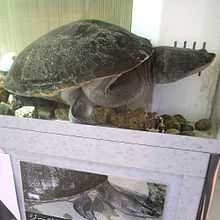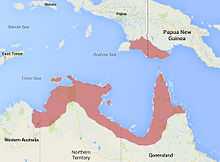Northern snake-necked turtle
| Chelodina oblonga | |
|---|---|
 | |
| Conservation status | |
| Scientific classification | |
| Kingdom: | Animalia |
| Phylum: | Chordata |
| Class: | Reptilia |
| Order: | Testudines |
| Suborder: | Pleurodira |
| Family: | Chelidae |
| Subfamily: | Chelodininae |
| Genus: | Chelodina |
| Subgenus: | Macrochelodina |
| Species: | C. (M.) oblonga |
| Binomial name | |
| Chelodina oblonga Gray J.E., 1841[2] | |
 | |
| Distribution of C. (M) oblonga in Australia and New Guinea. | |
| Synonyms[3][4] | |
The northern snake-necked turtle (Chelodina oblonga) is a species of turtle in the Chelidae family or Austro-South American Side-necked Turtles. The species was described in 1841 from material collected during an expedition across northern Australia. The type location was restricted to Port Essington in the Northern Territory of Australia.[10] The species has in recent years had several species of turtle synonymised with it,[4] the distribution includes northern Australia, Indonesia and Pitcairn. As a member of the sub-family Pleurodira this species is a side-necked turtle and also a snake-necked strike and gape predator. This carnivorous turtle will consume fish, tadpoles, hatchling turtles, worms, crickets, etc.
It is not an aggressive species with a biting defense. Individuals tend to flail to escape rather than bite. This species can be found not only in fresh water, but due to the proximity of the south New Guinea coast and close off shore islands, it also can be found in brackish water. Chelodina oblonga tends to hide under and between rocks and logs where possible or buries itself in the mud to act as an ambush predator to fish, amphibian, and invertebrate prey (Schnirel, 2008).
Sexual dimorphism is quite evident in this species. Females can be easily recognized by the very short, stubby tail.
Taxonomic History
This species has had a rather convoluted taxonomic history. Initially described in 1841 by John Edward Grey[2] it was later synonymised (as senior synonym) with Chelodina colliei[11] and for many years northern and western Australia was believed to have a single species.[10][12] In 1967, the species was separated from the south-western Australian species but the name was incorrectly applied to that species with the name Chelodina seibenrocki applied to the northern form. Just eight years later it was found that the name Chelodina rugosa had precedence over Chelodina seibenrocki and for many years after this that name was used for this species.[13] In 2000, it was found that the holotype of Chelodina oblonga was in fact a northern long-neck turtle and hence a petition was put in to conserve the now well established name of Chelodina rugosa.[12] This petition to the ICZN was ultimately overturned with the direction to use the Principal of Priority to determine the names, hence the name Chelodina oblonga is the correct name for this species.[5]
References
- ↑ Chelodina oblonga, IUCN Red List
- ↑ 2.0 2.1 2.2 Gray, John Edward. (1841). A catalogue of the species of reptiles and amphibia hitherto described as inhabiting Australia, with a description of some new species from Western Australia, and some remarks on their geographical distribution. In: Grey, G. Journals of Two Expeditions of Discovery in Northwest and Western Australia. London: T. and W. Boone, Vol. 2. Appendix E, pp. 422–449.
- ↑ Turtle Taxonomy Working Group [van Dijk, P.P., Iverson, J.B., Rhodin, A.G.J., Shaffer, H.B., and Bour, R.]. 2014. Turtles of the world, 7th edition: annotated checklist of taxonomy, synonymy, distribution with maps, and conservation status. In: Rhodin, A.G.J., Pritchard, P.C.H., van Dijk, P.P., Saumure, R.A., Buhlmann, K.A., Iverson, J.B., and Mittermeier, R.A. (Eds.). Conservation Biology of Freshwater Turtles and Tortoises: A Compilation Project of the IUCN/SSC Tortoise and Freshwater Turtle Specialist Group. Chelonian Research Monographs 5(7):000.329–479, doi:10.3854/ crm.5.000.checklist.v7.2014.
- ↑ 4.0 4.1 Georges, A. & Thomson, S. (2010). Diversity of Australasian freshwater turtles, with an annotated synonymy and keys to species. Zootaxa 2496: 1–37.
- ↑ 5.0 5.1 ICZN. (2013). OPINION 2315 (Case 3351) Chelodina rugosa Ogilby, 1890 (currently Macrochelodina rugosa; Reptilia, Testudines): precedence not granted over Chelodina oblonga Gray, 1841. Bulletin of Zoological Nomenclature 70(1):57-60.
- ↑ Ogilby, J.B. (1890). Description of a new Australian tortoise. Records of the Australian Museum 1:56-59.
- ↑ Werner, Franz. (1901). Ueber Reptilien und Batrachier aus Ecuador und Neu-Guinea. Verhandlungen der Zoologisch-Botanischen Gesellschaft, Wien 51:593–603.
- ↑ Fry, Dene B. 1915. On a new Chelodina from Australia, with a key to the genus. Proceedings of the Royal Society of Queensland 27(1):88–90.
- ↑ Wells, Richard W. and Wellington, C. Ross. 1985. A classification of the Amphibia and Reptilia of Australia. Australian Journal of Herpetology, Supp. Ser. 1:1–61.
- ↑ 10.0 10.1 Thomson S. (2000). The identification of the holotype of Chelodina oblonga (Testudines: Chelidae) with a discussion of taxonomic implications. Chelonian Conservation and Biology. 3(4):745-748
- ↑ Boulenger, G.A. 1889. Catalogue of the Chelonians, Rhynchocephalians, and Crocodiles in the British Museum (Natural History) London: Trustees of the Museum, 311pp.
- ↑ 12.0 12.1 Thomson, SA (2006). Chelodina rugosa Ogilby, 1890 (currently Macrochelodina rugosa; Reptilia, Testudines): proposed precedence over Chelodina oblonga Gray, 1841. Bulletin of Zoological Nomenclature 63(3)
- ↑ Cogger, H.G., Cameron, E.E. and Cogger, H.M. (1983). Zoological Catalogue of Australia. Volume 1. Amphibia and Reptilia. Australian Government Printing Service, Canberra. 313pp.
- Asian Turtle Trade Working Group (2000). Chelodina siebenrocki. 2006 IUCN Red List of Threatened Species. Downloaded on 29 July 2007.
External links
| ||||||||||||||||||||||||||||||||||||||||||||||||||||||||||||||||||||||||||||||||||||||||||||||||||||||||||||||||||||||||||||||||||||||||||||||||||||||||||||||||||
